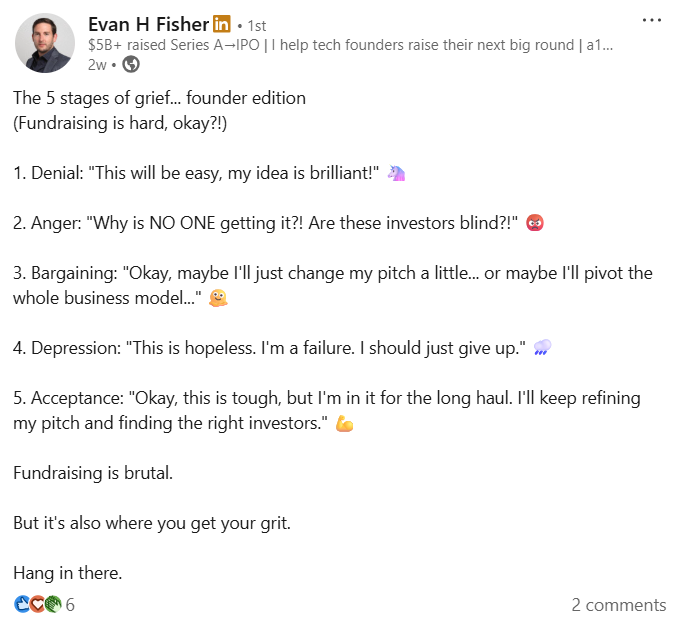I met a founder last year who was doing everything right.
The product worked.
The numbers looked good.
The story made sense.
Still, investor after investor said no.
Different reasons. Same outcome.
When we sat down to figure out what was happening, I realized the problem wasn't the business.
It was the perception.
They weren't rejecting the company. They were rejecting the risk they thought they saw.
Rejected founders compartmentalize & polarize to save their ego, instead of trying to discover the real reason they got turned down.

Most founders take investor rejection personally.
They think it's about the business or the idea.
It usually isn't.
It's about timing, traction, and how risky you look.
Investors are trained to say no. [Success as an investor is more about avoiding bad deals than anything else]
Your job: Remove the reasons they have to doubt you, mistrust you and your business.
Why Founders Keep Striking Out with Investors
.png)
Here's what's really going wrong:
- You're pitching too early. Investors don't fund potential. They fund proof.
- You're hard to believe. No track record, no credibility, no reason to trust.
- You're talking to one investor at a time. That kills urgency and leverage.
- You're guessing their objections. And guessing wrong.
- You're not building momentum. One lonely "maybe" won't move your round.
It's probably not that your business isn't good enough.
It's that your process is working against you.
The good news? You can fix this.
Once you get how investors think, you can flip the script and make their doubt work in your favor.
Here's the same plan I use when coaching founders who are tired of hearing "no."
Step 1: Understand the Real Objections
Most investors will never tell you the real reason they passed.
You'll hear nice phrases like "too early" or "not the right fit."
Translation: "We don't believe the timing, traction, or execution risk adds up."
Here's how to dig deeper without sounding defensive:
- Ask: "What signals would you want to see that would tilt this more toward Yes?"
- Listen to what they focus on
- Track repeated patterns (meaning, across multiple great-fit investors) — that will give you datapoints toward what to fix next.
I once worked with a founder who realized 7 out of 10 rejections were about missing product-market fit proof.
He paused his raise for two months, added 50 beta users & built a massive email list, and went back to the same investors.
Another founder kept hearing "your unit economics don't work."
Instead of arguing, she ran a 30-day test with stricter CAC targets, cut acquisition costs by 40%, and sent the results to everyone who passed. Three of them reopened the conversation.
She closed the round in 3 weeks.
Step 2: Build Credibility Before the Ask
.png)
Here's a truth most founders hate: cold pitches almost never work.
Because credibility doesn't start in the meeting. It starts months before.
Plan for 3-6 months of visibility before you ask for money.
That's how long it takes to go from "who's this?" to "oh, I know them."
If you want investors to lean in instead of lean back, you need to:
- Get warm introductions from people they already trust
- Share traction updates - and occasionally, your L’s too - publicly and often
- Post insights or mini stories that show how you think
You don't need thousands of followers.
You need the right people seeing you think clearly and execute well.
Investors back founders who act like real operators long before the money shows up.
You don't need a PR team to do this. Just show up regularly.
The founder who's visible, clear, and credible is the one who gets the meeting — and the check.
Step 3: Create Optionality
This is where things really change.
You want investors to feel like they might miss out.
That doesn't happen when you chase one conversation at a time.
It happens when you run a structured fundraising process that builds momentum.
- Line up multiple investor calls in the same 2–3 week window
- Start soft circling commitments early — “We already have X% of the round spoken for.”
- Never sound desperate — sound in demand.
Red flags that kill momentum:
- Saying "we're flexible on terms" too early (shows weakness)
- Taking months between investor conversations (looks like no one's interested)
- Oversharing about rejections (kills confidence)
- Asking for advice when you really want money (wastes everyone's time)
Soft circling is a credibility signal.
It tells investors, “This deal is moving, with or without you.”
That pressure gets responses, shortens timelines, and boosts valuations.
Here's the bottom line:
Most investor "no's" aren't rejections. They're clues.
Your job is to read them, fix the weak spots, and build leverage.
Once you do that, "no" turns into "not yet," and "not yet" becomes "how can we join?"
The founders who master this don't chase money.
They attract it.
There are 4 ways I can help you:
02. Deep-dive Digital Courses for Founders — Self-paced courses teaching you to overhaul your pitch, find investors & get funded faster.
03. 1-on-1 Capital Raise Coaching — Build your pitch. Find your best investors. Get them interested. Close your round.
04. Promote Your Business to 2K+ Weekly Readers — Want to grow your audience, subscribers, or customer base? Showcase your brand inside of my newsletter.
